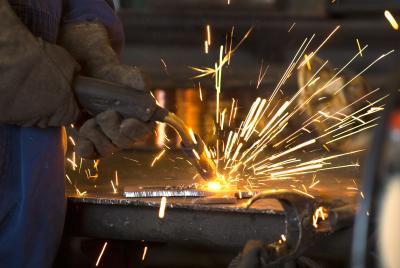
When welding stainless steel, the welding process that you use will determine the type of tools needed to clean the weld. TIG (tungsten inert gas) welding leaves no residue and generally will leave a rainbow-effect discoloration along the weld bead. MIG (metal inert gas) welding leaves a lot of black carbon discoloration that is quickly cleaned off the weld using the same tool set needed to remove the rainbow discoloration from a TIG weld. When you stick-weld stainless steel, you will need to perform the additional step of removing the slag from the surface of the weld bead.
Put on safety glasses and leather work gloves. You need to use leather work gloves, as they offer better protection against a spinning wire wheel than fabric work gloves. Skip to Step 3 if you are cleaning a MIG or TIG weld.
Remove the slag from the surface of the weld by lightly tapping along the weld bead with the chipping hammer and clean the slag away from the weld area with a dust brush.
Inspect the 4-inch grinder for any signs of damage. Do not forget to inspect the electrical cord for nicks and cuts; check that the ground prong is intact.
Attach the 4-inch wire wheel to the grinder.
Depress the trigger of the 4-inch grinder to spin the wire wheel, tilt the spinning wire wheel at a 15-degree angle to the weld bead, and drag the wire wheel along the weld bead.
Continue working the wire wheel along the weld bead until all signs of discoloration are removed from the weld.
Cut the abrasive scouring pad in half with a pair of scissors.
Determine the way the grain of the stainless steel meets the weld bead. If the weld bead runs parallel to the weld bead, run the scouring pad along the weld to remove the scuffs caused by the wire wheel. Work the scouring pad perpendicular to the weld bead if the grain runs toward the weld bead.
Wipe the dirt created by the scouring pad away from the weld bead after the scuffs from the wire wheel have been removed.